Dreams Enough To Share – Ray Jackson Interview
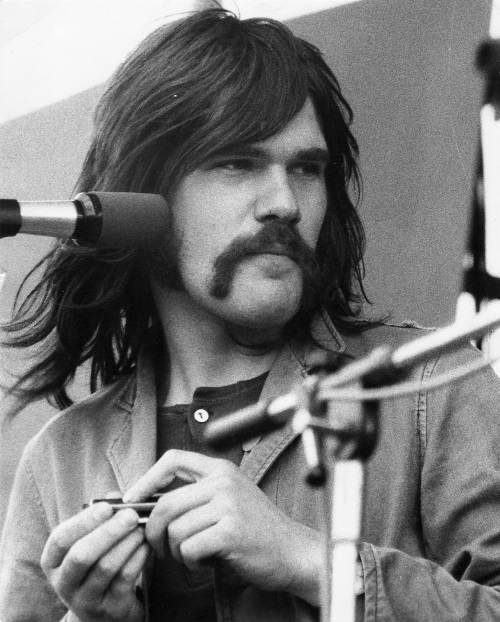 The Doc was preparing dinner after a knotty day re-tuning knackered harps, when there was a knock on the Surgery’s back window. Wiping sun-dried tomato oil from his fingers, he unlatched the top half of the kitchen door.
The Doc was preparing dinner after a knotty day re-tuning knackered harps, when there was a knock on the Surgery’s back window. Wiping sun-dried tomato oil from his fingers, he unlatched the top half of the kitchen door.
It was Stomping Stu from the local allotment. ‘Aaaaah, hello Doc!’ Stu spluttered, cycling hat askew and cheeks flushed, ‘I was just passing and thought you might like these’. He waved a bunch of purple-sprouting broccoli. ‘Excellent timing dear boy,’ the Doc replied, ‘come on in. Fancy some pasta?’.
‘Sounds v-very nice, thank you,’ Stu stammered. ‘I’ve b-been reading your old post about Paul Jones and the B-Blues B-Band’s Flat Foot Sam track’, said Stu, initiating the evening’s topic of conversation.  ‘Ah yes,’ Doc replied, ‘a very nice man and a great band. Was that the post about Knebworth 1980?’. ‘Yup! I think you said Lindisfarne were on the same bill. I wonder what ever happened to Ray Jackson? He was a handy harp player’.
‘Ah yes,’ Doc replied, ‘a very nice man and a great band. Was that the post about Knebworth 1980?’. ‘Yup! I think you said Lindisfarne were on the same bill. I wonder what ever happened to Ray Jackson? He was a handy harp player’.
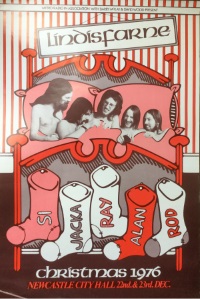 ‘Jacka? I believe he left the band a few years later when they recorded a rap version of Fog On The Tyne with Gazza. Felt they were selling out. He’s since opened his own art shop. Some of the band met at Art College; I think he designed their album covers. Does his own paintings of vintage busses now; pretty canny like.’ The Doc attempted a poor Geordie accent. ‘They were from Newcastle Doc, not Uttar Pradesh’, Stu chuckled. The Doc disappeared for a few moments.
‘Jacka? I believe he left the band a few years later when they recorded a rap version of Fog On The Tyne with Gazza. Felt they were selling out. He’s since opened his own art shop. Some of the band met at Art College; I think he designed their album covers. Does his own paintings of vintage busses now; pretty canny like.’ The Doc attempted a poor Geordie accent. ‘They were from Newcastle Doc, not Uttar Pradesh’, Stu chuckled. The Doc disappeared for a few moments.
He returned with a copy of Nicely Out Of Tune, grinning from ear to ear. ‘Sorry if that was a bit rude of me’, Stu apologised. ‘No offence taken old boy, my Geordie accent’s a bit ropy. I’ve just been on the blower and I may have tracked Jacka down’. He hurried into the study, slipped the LP from its sleeve and placed it on the turn table. As the pink Charisma label revolved, the captivating strains of Lady Eleanor rolled from the stereo system, complete with Ray’s resonant mandolin.
The Doc and Ray reminisced about one particularly wonderful mid-summer’s day at Knewborth..
What do you recall of that special day at Knebworth 1980 Ray?
I remember being on tour in 1980 with Lindisfarne and Knebworth was part of the band’s itinerary. We had a police motorcycle escort from our hotel in Letchworth to the festival site which was weaving at great speed through small villages and narrow lanes. Our coach driver could barely keep pace behind them but the whole experience was great fun and a first for us.
Entering the festival at the back stage compound we were shown our dressing room and tune-up area. I remember going to the tune-up room (others to the bar), where my Fender Champ amp had been set up by our road manager. Carlos Santana happened to be playing his guitar through it as I walked in. I listened to him playing, enjoying this treat of hearing him all by myself. He asked me who the amp belonged to as he liked the sound it made and I said it’s mine mate. Carlos said, is it for sale? I had to tell him it wasn’t. I still use this Fender Champ for harmonica because of the great sound it produces.
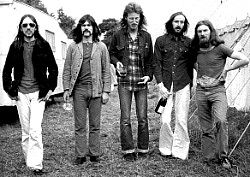 The late Gus Dudgeon, who produced Back and Forth and Magic In The Air, a great friend and a great producer, came to visit us in the dressing room, bringing with him Elkie Brooks who we hadn’t met before. Our key board player at the time, was a nervous Alan Clarke who went on to great acclaim playing with Dire Straits. My favourite band on the bill was the Beach Boys, who Lindisfarne had last supported in the early 70’s in Syracuse, New York State, on our first tour of the USA. Great footage of us Knebworth was captured on film and we were the first band to get the audience on their feet; our usual long time festival party trick. Great audience, great gig.
The late Gus Dudgeon, who produced Back and Forth and Magic In The Air, a great friend and a great producer, came to visit us in the dressing room, bringing with him Elkie Brooks who we hadn’t met before. Our key board player at the time, was a nervous Alan Clarke who went on to great acclaim playing with Dire Straits. My favourite band on the bill was the Beach Boys, who Lindisfarne had last supported in the early 70’s in Syracuse, New York State, on our first tour of the USA. Great footage of us Knebworth was captured on film and we were the first band to get the audience on their feet; our usual long time festival party trick. Great audience, great gig.
Lindisfarne certainly made a lasting impression. Is there a particular harp you favour?
Yes, the diatonic scale Hohner Special 20, which I use mainly for blues, although I have recently tried the Marine Band Deluxe harp which has a great sound. 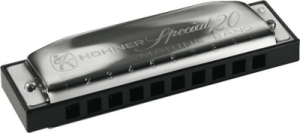 The reeds are louder and more flexible for note bending. I like the Lee Oscar natural minor also for playing jazz orientated songs in minor keys. I have a couple of Hohner Chromonica 270s in C and G, which help give a melodeon type of sound for traditional folk tunes.
The reeds are louder and more flexible for note bending. I like the Lee Oscar natural minor also for playing jazz orientated songs in minor keys. I have a couple of Hohner Chromonica 270s in C and G, which help give a melodeon type of sound for traditional folk tunes.
When and why did you take up the harmonica?
My Godmother gave me my first harmonica when I was still at junior school. Her son Alan, was in the forces in Singapore and had left a mouth organ in the drawer of her sideboard. It had been there for a few years and I asked if I could play it.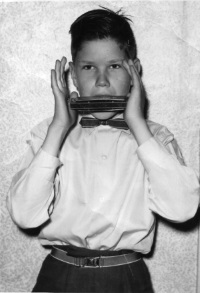 To everyone’s surprise I quickly got a tune out of it and she gave it to me to keep, saying her son would not be needing it in a hurry. It was a traditional type of harmonica, one with built in tremolo on each note. It was my first musical instrument and I was determined to master it.
To everyone’s surprise I quickly got a tune out of it and she gave it to me to keep, saying her son would not be needing it in a hurry. It was a traditional type of harmonica, one with built in tremolo on each note. It was my first musical instrument and I was determined to master it.
I had no tuition but had an ear for music and started listening to lots of stuff on the radio – such as The Navy Lark – and also early TV programmes; Dixon of Dock Green, and BBC light entertainment programmes featuring acts like The Harmonica Rascals and Morton Frazer. My Granddad heard me playing one Sunday on a visit to his house and revealed that he had once played. He brought out his long forgotten “moothie” (as he named it) and started to teach me a few Geordie and Scottish tunes. 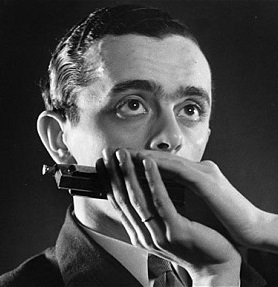 It was an Echo Super Vamper, which I noticed was different to mine. To achieve vibrato on a note you had to cup the instrument in your hand and move the shape of your hand in and out. He also taught me how to vamp by blocking the notes with the tongue in time to the music.
It was an Echo Super Vamper, which I noticed was different to mine. To achieve vibrato on a note you had to cup the instrument in your hand and move the shape of your hand in and out. He also taught me how to vamp by blocking the notes with the tongue in time to the music.
I realised after listening to other players that my harmonica was limited and unable to achieve what Larry Adler and Tommy Riley were playing. I asked my parents if I could have a chromatic for my birthday. Realising I had some aptitude for playing, they forked out for one and I was soon able to emulate the greats. Soon my mother, who had become proud of my playing, started exploiting my talent by putting me forward for appearances at local W.I. meetings. On a holiday to Butlin’s Filey in 1960, I was reluctantly put forward to take part in a talent contest and won my heat. The same happened again the following year when I was presented with a silver cup.
What inspired the folk side of your playing and song writing?
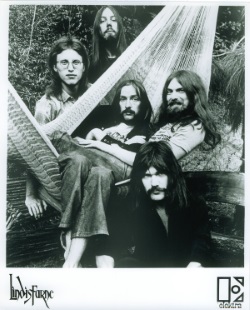 I became interested in folk and blues playing after hearing Bruce Channel’s Hey Baby and John Lennon playing on Love Me Do. Investigating further, I realised that in playing the chromatic I was unable to get the same sound as I was hearing on blues records. Bo Diddley’s Pretty Thing was the first song I heard where the harmonica of Lester Davenport completely changed my perception of what the harmonica could do. It was the Chicago blues style and could only be played effectively on a diatonic harp.
I became interested in folk and blues playing after hearing Bruce Channel’s Hey Baby and John Lennon playing on Love Me Do. Investigating further, I realised that in playing the chromatic I was unable to get the same sound as I was hearing on blues records. Bo Diddley’s Pretty Thing was the first song I heard where the harmonica of Lester Davenport completely changed my perception of what the harmonica could do. It was the Chicago blues style and could only be played effectively on a diatonic harp.
I was soon listening to Sonny Terry, Little Walter, Shakey Horton, Sonny Boy Williamson, Slim Harpo and Noah Lewis and started playing blues in the folk clubs from around 1964/5. I discovered Woody Guthrie’s music while browsing through LP’s in my local record store. On one particular album, accompanying him was Sonny Terry (harmonica) and Cisco Houston (mandolin). The combination of Guthrie’s songs and the harmonica and mandolin registered with me. I brought this influence to the table when I joined Lindisfarne a few years later.
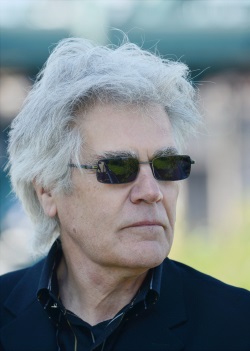 It sounds like you had a very supportive family.
It sounds like you had a very supportive family.
Yes my family were quite supportive and obviously proud when I achieved chart success. I was the first in the family to play music professionally.
You were at art college with Ray Laidlaw. Who initiated things?
I first met Ray Laidlaw through the local gig circuit, where we played in separate groups in the Tyneside area. It wasn’t until our meeting at college that we struck up a friendship. During this period Ray asked me if I would like to replace their singer who was leaving his group. Without hesitation I decided to take him up on it. Their music was much more blues based than my band and they had started writing a lot of their own material. There was also a record deal in the offing, so if I needed a final shove to make a career from music, this was it.
The band was called Downtown Faction and their lead guitar player Jeff Sadler was quite a talent, sounding like Jeff Beck, Clapton and Harvey Mandel all put together. He was at school at the same time as Mark Knopfler and I believe influenced Mark’s style of playing. Sadly after a year of me joining, our lead guitarist left to pursue a career with his father’s building firm and Ray, Simon, Rod and myself, had to reinvent ourselves. We changed our name to Brethren.
Our style of playing became more acoustic and lent itself to smaller venues. We started playing the folk club circuit, which had expanded rapidly due to the popularity of American protest singer-songwriters. Accepted even by the more traditional style of folk club, we were soon in demand, particularly in the North East.
 One club was run by singer-songwriter Alan Hull. We were booked to support Ralph McTell at Alan’s club in Whitley Bay and he was so impressed with our performance that he asked if we would join forces with him to play on his demo recordings.
One club was run by singer-songwriter Alan Hull. We were booked to support Ralph McTell at Alan’s club in Whitley Bay and he was so impressed with our performance that he asked if we would join forces with him to play on his demo recordings. 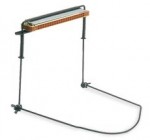 The chemistry between us developed and was soon to emerge as the sound of Lindisfarne. Playing in folk clubs was sometimes daunting because they could be a tough and critical audience, but the experience and influence we gained was invaluable and helped to create our individual style.
The chemistry between us developed and was soon to emerge as the sound of Lindisfarne. Playing in folk clubs was sometimes daunting because they could be a tough and critical audience, but the experience and influence we gained was invaluable and helped to create our individual style.
Your harmonica sound on Meet Me On The Corner is very special.
It was influenced by one man band harness playing. The song was in the style of a busker.
Do you follow a set chord pattern, the melody or a breathing pattern when you’re playing it?
I’m simply blowing the root chord, which is in A, and inhaling at intervals for the changes. I overdubbed on the verses where I sang the verse and chorus.
I notice the chord changes are punctuated by a bent tug in 3 draw. Are you a natural puckerer?
Well observed, I pucker naturally!
On Dingly Dell, there’s a 17 minute live recording of We Can Swing Together, 8 minutes of which is a solo harmonica medley. Was this a one-off?
The recording you mention is from a later CD compilation placed on Dingly Dell as an extra track, or filler. I believe the harmonica piece was originally recorded for a Lindisfarne Live album.
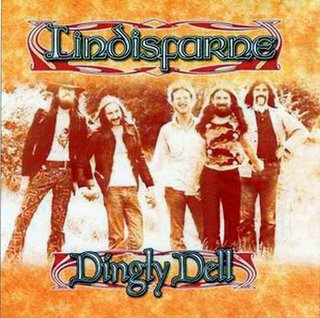 I had developed the medley as a party piece at live gigs; some harmonica tunes of mainly North Eastern tunes arranged for inclusion in We Can Swing Together. The song was about a party in Newcastle-upon-Tyne which was raided by the police – hence the Z Cars theme and police siren at the end of the medley. It lent itself well to our popular Christmas shows, where I would include some yuletide songs like Rudolf The Red Nosed Reindeer and Jingle Bells, and get the audience to sing and join in.
I had developed the medley as a party piece at live gigs; some harmonica tunes of mainly North Eastern tunes arranged for inclusion in We Can Swing Together. The song was about a party in Newcastle-upon-Tyne which was raided by the police – hence the Z Cars theme and police siren at the end of the medley. It lent itself well to our popular Christmas shows, where I would include some yuletide songs like Rudolf The Red Nosed Reindeer and Jingle Bells, and get the audience to sing and join in.
How did you remember all the melodies?
I didn’t have anything written down and would sometimes adapt the melodies to suit the town or area we were playing. If it was Nottingham, I would throw in the theme tune from Robin Hood, or a Scottish tune for Glasgow or Aberdeen. I came unstuck with this once when I was playing at a festival in Milan, Italy. I accidentally went into Arrivederci Roma and was immediately booed and pelted with ripe fruit. Needless to say, I didn’t make that mistake again!
You saw some of America’s top blues harmonica legends in the 1960’s. What are your memories?
I was lucky enough to see two blues harmonica legends from the US, Sonny Boy Williamson and Little Walter. I remember seeing Little Walter during Newcastle University rag week in late 1964 at the Majestic Ballroom. I’d heard  him play with Muddy Waters on record and on tracks of his own such as My Babe. It was a thrill to see him play on stage. He was backed by a British band called the Bobby Patrick Big Six. American acts were obliged to use British musicians to tour with them because of strict MU rules in force then but the band played sympathetically behind him.
him play with Muddy Waters on record and on tracks of his own such as My Babe. It was a thrill to see him play on stage. He was backed by a British band called the Bobby Patrick Big Six. American acts were obliged to use British musicians to tour with them because of strict MU rules in force then but the band played sympathetically behind him.
The in-house PA systems were used in those days, with nothing being amplified through them other than the vocals, but his playing cut through as it did on his recordings. I found it hard to believe that I was actually able to listen to him play and watch him at the same time. He used a chromatic on songs in a minor key and a diatonic for cross harp, revealing some of the secrets of his technique, which I found invaluable in developing my own style of playing. Newcastle had a budding music scene in the 60’s and a wealth of venues for seeing acts from both sides of the pond. The best of the bunch was the Club A’ Go Go where the Animals had started their career.
This club was where I was lucky enough to watch Sonny Boy Williamson play. My memory of who was backing him is a little sketchy, but I think it may have been the Yardbirds.  He sang and played through an open microphone and used his hands, cupping the harp and shaping the notes to get a rich sound, which I thought was almost impossible from such a tiny instrument.
He sang and played through an open microphone and used his hands, cupping the harp and shaping the notes to get a rich sound, which I thought was almost impossible from such a tiny instrument.
His tone was incredible and he made it look effortless. During one song he dipped his harp into what I took to be a glass of whisky and continued playing. I assumed this was to help clear the reeds, but have since learned he had bleeding gums – the whisky helped the problem by soothing them. He was already quite old, probably well into his seventies, sitting down for most of his time on stage, but I feel privileged to have witnessed him performing and the memory will stay with me forever.
Are there any current projects you’d like folks to know about?
I don’t have anything in the pipeline for the time being and consider myself almost retired. There are a couple of albums I have recently contributed to, but I’m not sure they are available yet. One is The Gathering’s The Bridge Between, featuring Jerry Donahue, Clive Bunker, Rick Kemp and the band, and then there’s Ray Jackson’s Lindisfarne CD, Live at Newcastle City Hall.
I’ve sent you an mp3 of me playing a live version of ‘Evening’ using a Lee Oscar minor key harp taken from a Lindisfarne live Album recorded in 2013. I hope you like it.
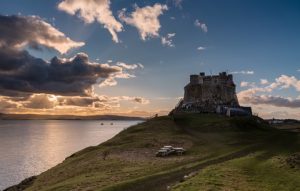 ‘And that Stu, is the latest on the wonderful Ray Jackson. Top bloke. His harmonica playing on the Evening track he kindly sent is exceptional.’ By now Roll On Ruby had replaced Nicely Out of Tune on the turntable. ‘He’s the man who also played mandolin on Rod Stewart’s Maggie May hit.’ ‘I never knew that’, Stu replied through a mouthful of tagliatelle. ‘His riffs on Lady Eleanor remind me of Crowded House’s Always Take The Weather, I don’t suppose he..’, the Doc cut him off. ‘How’s the pasta Stuey old boy?’. ‘Very good thank you. I’m enjoying the b-broccoli too’. ‘Talking of pasta old chap, apparently’, the Doc announced, trying to keep a straight face, ‘Al-Qaeda have started hiding bombs in tins of Alphabet Spaghetti’. ‘Really?’, said Stu, ‘That’s despicable, whatever next?’ ‘I agree’, the Doc quipped, ‘if they go off, it could spell disaster’.
‘And that Stu, is the latest on the wonderful Ray Jackson. Top bloke. His harmonica playing on the Evening track he kindly sent is exceptional.’ By now Roll On Ruby had replaced Nicely Out of Tune on the turntable. ‘He’s the man who also played mandolin on Rod Stewart’s Maggie May hit.’ ‘I never knew that’, Stu replied through a mouthful of tagliatelle. ‘His riffs on Lady Eleanor remind me of Crowded House’s Always Take The Weather, I don’t suppose he..’, the Doc cut him off. ‘How’s the pasta Stuey old boy?’. ‘Very good thank you. I’m enjoying the b-broccoli too’. ‘Talking of pasta old chap, apparently’, the Doc announced, trying to keep a straight face, ‘Al-Qaeda have started hiding bombs in tins of Alphabet Spaghetti’. ‘Really?’, said Stu, ‘That’s despicable, whatever next?’ ‘I agree’, the Doc quipped, ‘if they go off, it could spell disaster’.
CREDIT
With thanks to Ray Jackson for being a willing interviewee (between a wet week or two in France), for his great archive pictures and his great harmonica recordings.


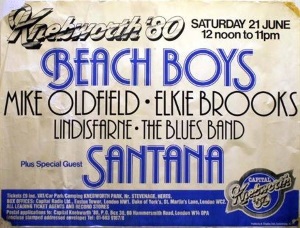
Met the band in the late 70s after a gig in Preston, love lindisfarne to this day and still play them, the article brought back many happy memories, thanks.
Can still see Jacka now in his white jacket ……multi talented. .London bus etc…
Great to hear from Jacka. I feel that he was a most underrated musician. Lindisfarne were/are such a special band for ‘The People’. Think I will put on some Lindisfarne now ,and hopelessly try and play harp like jacka. Thanks for ‘Harp Surgery’, all the best ,Dave.
Hi Mel, thanks for dropping by. Thrilled you enjoyed the interview. A very fine band indeed. Do you like broccoli too? Doc
Hi Nick. They ignited the audience at Knebworth that day. Something they were adept at by all accounts. Thanks for dropping in. Doc
Hi Dave, it was only through our chat and then thoroughly investigating the band’s back catalogue that it became so apparent that Jacks and the rest of the band are a national treasure. As you say, such capable, multi-instrumentalists and songwriters. Doc
This was a Truely memorable trip down memory lane. Wishing you all the best.
Thanks Suzi Q. So glad you enjoyed the post. Please visit the Surgery again very soon. The pasta is to die for. Doc x
Followed Ray since 71. Bought maggie may. My first ever record because of the mandolin riff. Also purchased fog on the tyne my first Album. Rays recent Xmas shows evoked memories of the 70s concerts. Next time you pass through the Oxfordshire countryside call in and see his brilliant artwork. Talk about being multi-talented.
Eat your heart out Mr Stewart!
That was a pretty in depth interview of the Mr Jacka. Well versed and insightful albeit too brief when we get chance to read about some of the most wonderful harmonica players this country has produced.
I saw them at the Belfry in Sutton Colefield which sadly now has turned into a venue where exclusive knobs bang ping pong sized balls around a field with golf bats.
Ah, them were the days of yore.
Initially I came on here to find out what harmonica Ray used when playing “we can swing together”. I remember watching the live show at Newcastle one Christmas many years ago on the BBC. I wished I’d taped the damn thing! So I got he next best thing and that was the live show on Vinyl. It was Ray’s playing that inspired me to learn the harmonica. Ok, I’m still learning and I STILL don’t know what harmonica he played on that song !!!!! Help me!
Oh, Now that I’ve found this website, I’m in!
Great interview Ray’s harmonica sends shivers down my spine and also love the mandolin. So wish Ray would just pop on stage at City Hall on 17th December 22, just for one or two numbers, not really too much to ask….that would be dreams enough to share xx
I recall Ray using his extraordinary talent with the harmonica, and his mouth and hands, to play soundtracks of a shipyard worker’s day (with all possible sound effects) during their fantastic Christmas dates at Newcastle City Hall.